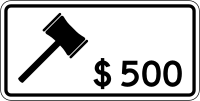Key:fine
 |
| Description |
|---|
| A signposted fine that is imposed for a specific traffic violation. |
| Used on these elements |
| Useful combination |
| Status: in use |
| Tools for this tag |
|
This key and its subkeys indicates a fine that is imposed by the authorities when someone is caught violating a specific traffic regulation.
As of 2021, this tagging scheme is heavily used in Metro Manila but also sees scattered use elsewhere.
Rationale
The fine for an identical violation may differ from location to location within the same jurisdiction, making this information potentially worth capturing in a geospatial database.[1] In general, OpenStreetMap only attempts to map traffic laws or associated financial penalties when they are signposted and thus verifiable on the ground and more stable. There is no obligation to comprehensively map every traffic law on the books.
How to map
How you map a fine depends on the nature of the traffic regulation. For example, a fine for running a red light would probably be tagged on the highway=traffic_signals node or enforcement=traffic_signals relation, while a fine for violating an HOV restriction would probably be tagged on the same way that has an hov=* tag. Make sure to tag the associated regulation or restriction, which is more likely to be understood by data consumers.
Add a subkey after fine=* to indicate the kind of regulation that the fine enforces. The value should follow the same format as charge=*: that is, a numeric monetary amount using . as the decimal separator, followed by a space, followed by a three-letter ISO 4217 currency code.
Here are some subkeys currently in use:
fine:foot=*+foot=no– a fine for walking on foot along a roadfine:hgv=*+hgv=no– a fine for trucks driving along a roadfine:hazmat=*+hazmat=no– a fine for transporting hazardous materials along a roadfine:parking=*orfine:parking:left=*/fine:parking:right=*/fine:parking:both=*– a fine for violating a parking or street parking restriction
Based on this usage, it follows that some restrictions may require the use of not:=* or conditional restrictions, for example fine:not:disabled=* to indicate a fine for illegally parking in a disabled parking space.
Examples
-
Canada (Ontario):
fine=500 CAD -
United States (California):
fine:traffic_signals=400 USD -
United States (New York City):
(How to tag points deducted from driving record?)
Statistics
The most common subkeys as of April 2022:




